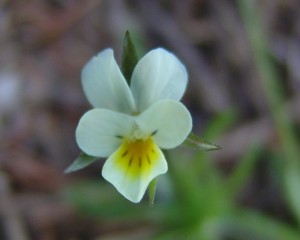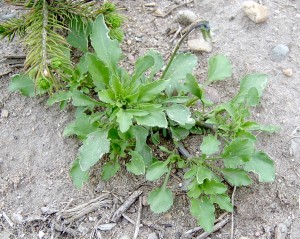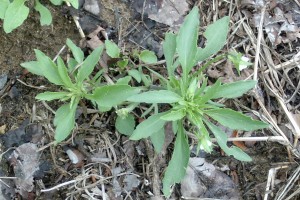
Field violet – Viola arvensis
Viola arvensis Murr.
Violaceae (Violet family)
MI Status
Non-native
Life cycle
Prostrate to ascending winter annual.
Leaves
Young leaves that develop from a basal rosette are round to oval with a few shallow teeth on the margins, long petioles and small stipules. Mature leaves are longer and narrower with round-toothed margins, hairy veins on the leaf underside and large, deeply lobed stipules.
Stems
Prostrate to ascending, multi-branched stems are less than 16 inches long.
Flowers and fruit
Flowers have five white to pale yellow petals sometimes tinged with purple. The lower petal is the largest and the sepals are the same length as the petals or slightly longer. Fruit are single-celled capsules with three valves.
Reproduction
Seeds.
Similar weeds
Common blue violet
(V. papilionacea Pursh)
Differs by having a perennial nature with rhizomes; basal, hairless, heart-shaped leaves with round-toothed margins; and blue to purple to occasionally white flowers.



Other Documents in this Series
You Might Also Be Interested In
-
MSU named Top 10 agriculture and forestry college in new report
Published on March 23, 2021
-
Update from the Chair, Fall 2020
Published on October 8, 2020
-
MSU research team receives USDA grant to evaluate effectiveness, cost of new blueberry pest management strategies
Published on February 19, 2021
-
CANR meets academic needs to prepare students for their futures
Published on February 1, 2020
-
MSU Product Center helps Michigan food entrepreneurs survive and thrive throughout pandemic
Published on August 31, 2021
-
Protecting Michigan’s environment and wildlife through the Conservation Reserve Enhancement Program
Published on September 1, 2021
Accessibility Questions:
For questions about accessibility and/or if you need additional accommodations for a specific document, please send an email to ANR Communications & Marketing at anrcommunications@anr.msu.edu.



 Print
Print Email
Email




